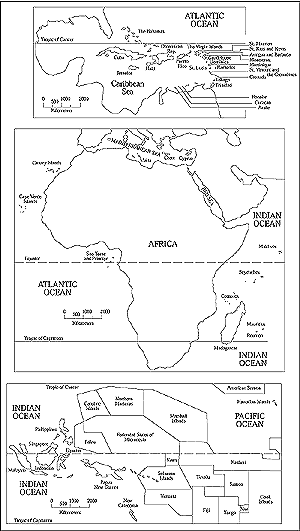
Figure 17-1: Main regions of the world in which small island states are located.
The Intergovernmental Panel on Climate Change (IPCC) in its Second Assessment Report (SAR) projected a global average temperature increase of 1.0-3.5°C, and a consequential rise in global mean sea level of 15-95 cm by the year 2100. Results from observational data show that temperatures have been increasing by as much as 0.1°C per decade and sea levels by approximately 2 mm yr-1 in the regions where most of the small island states are located—namely, the Pacific, Indian, and Atlantic Oceans and the Caribbean Sea (see Figure 17-1). There also is evidence that the ENSO phenomenon will continue to have a major influence on climate variability in these regions.
 Figure 17-1: Main regions of the world in which small island states are located. |
Analyses conducted by the New Zealand Meteorological Services reveal that, since 1920, temperature has risen by 0.6-0.7°C in Noumea (New Caledonia) and Rarotonga (Cook Islands), which is greater than the mean global increase. Based on data from 34 stations in the Pacific from about 160°E and mostly south of the equator, surface air temperatures have increased by 0.3-0.8°C during the 20th century, with the greatest increase in the zone southwest of the SPCZ. This is well in excess of global rates of warming. Further recent work undertaken by the New Zealand Institute of Water and Atmospheric Research (NIWA) shows a noticeable change in aspects of the South Pacific climate since the mid-1970s. For instance, western Kiribati, the northern Cook Islands, Tokelau, and northern French Polynesia have become wetter, whereas New Caledonia, Fiji, and Tonga have become drier. Meanwhile, Samoa, eastern Kiribati, Tokelau, and northeast French Polynesia have become cloudier, with warmer nighttime temperatures; New Caledonia, Fiji, Tonga, the southern Cook islands, and southwest French Polynesia and Tuvalu have become warmer and sunnier (Salinger et al., 1995). It also might be noted that in the Pacific generally, observed changes in temperature and cloudiness appear to be closely influenced by the pattern of ENSO events (Salinger, 1999).
The records also indicate that rainfall has increased in the northeast Pacific but has decreased in the southwest Pacific region. Interannual variations in temperature and rainfall are strongly associated with ENSO, resulting in water shortages and drought in Papua New Guinea, the Marshall Islands, the Federated States of Micronesia, American Samoa, Samoa, and Fiji. Although a causal link has yet to be established, all of the foregoing changes have coincided with an eastward shift of the SPCZ since 1970. Research now suggests that some of the foregoing changes (including the shift in the SPCZ) may be closely correlated with interdecadal patterns of variability—for example, the Pacific Decadal Oscillation (PDO) (Salinger and Mullen, 1999). It should be noted, nevertheless, that the changes observed in the 20th century are considered to be consistent with patterns related to anthropogenic GHG-induced climate change (Salinger et al., 1995; Hay, 2000).
The most significant and more immediate consequences for small island states are likely to be related to changes in sea levels, rainfall regimes, soil moisture budgets, and prevailing winds (speed and direction), as well as short-term variations in regional and local sea levels and patterns of wave action (Sem et al., 1996). The short-term (including interannual) variations are likely to be strengthened by the ENSO phenomenon. Vulnerability assessment studies undertaken in some small islands suggest that climate change will impose diverse and significant impacts on small island states (Leatherman, 1997). In most small islands (including the high islands), the majority of the population, socioeconomic activities, and infrastructure are located within a few hundred meters of the coast; therefore, they are highly vulnerable to the impacts of climate change and sea-level rise (Hay et al., 1995; Bijlsma, 1996; Nurse et al., 1998; Burns, 2000). In this regard, an increase in the frequency and magnitude of tropical cyclones would be a major concern for small island states. This would increase the risk of flooding, accelerate existing rates of beach erosion, and cause displacement of settlements and infrastructure.
The key questions, therefore, are how will the impacts manifest themselves, and what are the most appropriate responses for avoiding, minimizing, or adapting to these impacts? Because small island states traditionally experience some of the greatest interannual variations in climatic and oceanic conditions, many of their natural systems are well adapted to the stresses that result. Thus, many strategies that small island states might employ to adapt to climate change usually are the same as those that constitute sound environmental management, wise use of resources, and appropriate responses to present-day climate variability.
Although the full extent of climate change impacts in the small island states is far from certain, mostly adverse consequences are projected for several systems. The combined effect of GHG-induced climate change and sea-level rise can contribute to coastal erosion and land loss, flooding, soil salinization, and intrusion of saltwater into groundwater aquifers. The quantity and quality of available water supplies can affect agricultural production and human health. Similarly, changes in SST, ocean circulation, and upwelling could affect marine organisms such as corals, seagrasses, and fish stocks. Tourism—which is a very important economic activity in many island states—could be affected through beach erosion, loss of land, and degraded reef ecosystems, as well as changes in seasonal patterns of rainfall.
|
Other reports in this collection |